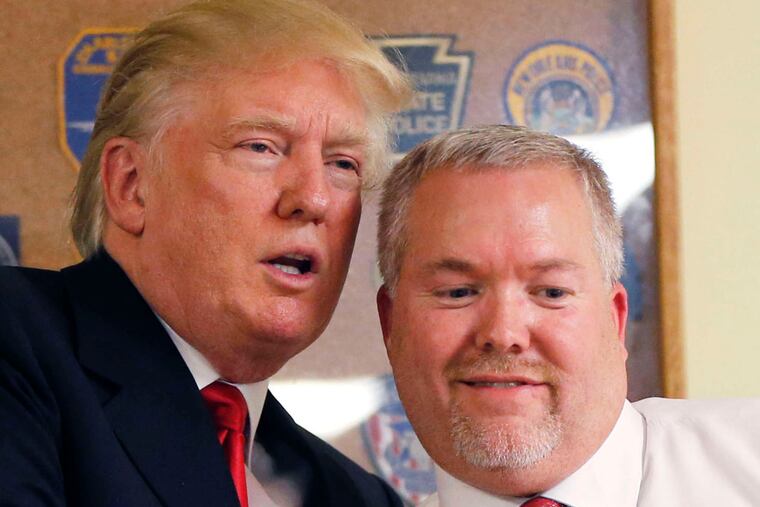Commentary: As Scranton goes in 2016 ...
It's not simply a handful of swing states that will decide the 2016 presidential election. The swing voters in the swing counties of the swing states will decide it. And if my calculations are correct, it is perhaps no more than 19 counties in 11 states - less than 500,000 voters - who truly matter. That's why Scranton seems to be so important this year.

It's not simply a handful of swing states that will decide the 2016 presidential election. The swing voters in the swing counties of the swing states will decide it. And if my calculations are correct, it is perhaps no more than 19 counties in 11 states - less than 500,000 voters - who truly matter. That's why Scranton seems to be so important this year.
From 1988 to 2012 the balance of power in U.S. presidential races has centered on 10 states. Republicans were likely to win 23 states, totaling 191 electoral votes, and the Democrats 18 states and the District of Columbia, with 232 electoral votes. There are 10 swing states - Colorado, Florida, Iowa, Nevada, New Hampshire, New Mexico, North Carolina, Ohio, Virginia, and Wisconsin - with a total of 115 electoral votes. These are the states where the presidential candidates campaign and visit after the conventions. They are the bellwether states, the battleground states. These states are the most likely to flip from one party to another, and the margin of election victory in each is generally close. Some, such as Florida and Ohio, are even more decisive than others in terms of their presidential selection influence.
These are still the crucial swing states in the 2016 election. Donald Trump's candidacy, both its strengths in appealing to white working-class voters, which may open up Pennsylvania as a swing state, or its weaknesses, such as its racial overtures that might make Utah and Georgia possible Democrat pickups, might change the electoral map slightly. But the Electoral College and the way states allocate their electoral votes, along with the rise of political polarization and the declining number of swing voters to perhaps 5 percent of the electorate, mean that, even this year, in approximately 40 states, the presidential race is largely already over.
But while pundits write about the swing states, more fascinating is how within them there are only a handful of counties that are decisive. They are the swing counties where the candidates actually campaign and where, if they can win them, they win the state. Since 1988 there have been a handful of swing counties. In Colorado it is Jefferson County that is key to winning that state. For New Hampshire, it is Hillsborough County, North Carolina has Wake County, and Virginia's is Prince William. In Florida it is Hillsborough, and in Ohio it is Hamilton. Win Hamilton you win Ohio; win Ohio you win the presidency.
In 2012 there were 15 counties in the 10 swing states that were critical to President Obama's reelection victory. There were about 3.88 million votes cast and Obama won 53.2 percent. He out-polled Mitt Romney by less than 350,000 votes. It is not clear whether Romney could have persuaded those voters to switch to him or whether he needed to mobilize others. The reality, however, is that across those 15 counties in 10 states, a switch of about 350,000 or so votes would now have Romney running for his second term in 2016.
Assume these are the same swing counties and states this year, and that the number of swing voters there is up to 500,000 with population growths. Now add Pennsylvania, a state that has voted solidly for the Democratic presidential candidate since 1988. Trump needs to flip it to win.
There are four counties - Bucks, Chester, Luzerne, and Lackawanna - that may be key to winning the Keystone State. Lackawanna - where Scranton is located - seems to be the center of Pennsylvania's political universe this year. Both Trump and Clinton have made recent visits there; expect more by November.
In 2012 almost 97,000 voted in Lackawanna County, with Obama winning nearly 63 percent. Flipping that county seems like a tall order. Yet these four counties had a total of 790,000 voters in 2012, and Obama won them with less than 52 percent - about a 26,000-vote spread. Conceivably, Trump could flip them. But, given that Obama won the commonwealth by more than 300,000 votes in 2012, Pennsylvania is a long shot.
Including Pennsylvania, there are only about 19 swing counties in this year's presidential contest that seem to matter, and the number of swing voters there may be less than 500,000. The key is moving these few swing voters in these swing states. The rest of us should vote, but the reality is that the next president will be selected by a few voters in a few counties.
David Schultz is a professor of political science at Hamline University in Minnesota and editor of the Journal of Public Affairs Education. dschultz@hamline.edu